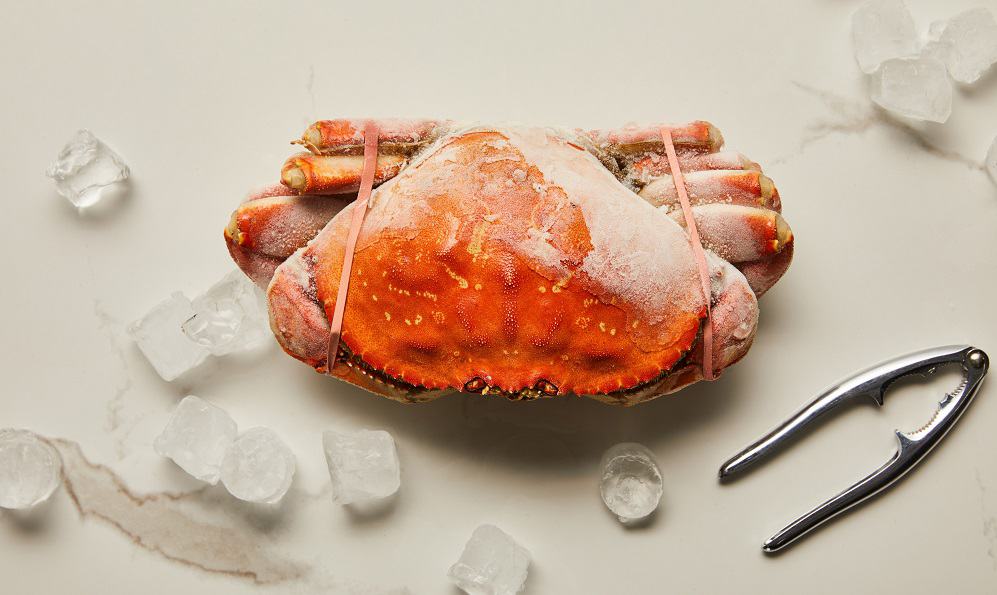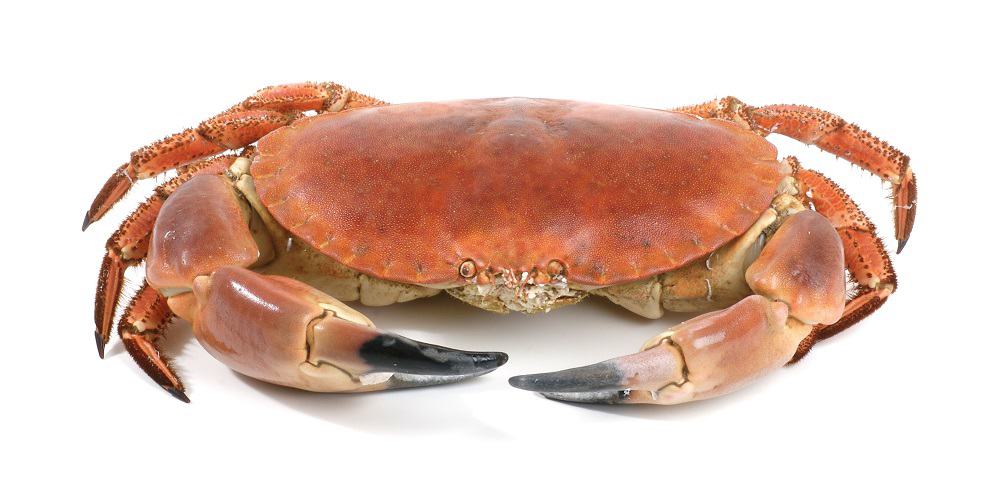Seafood is an excellent source of protein and omega-3 fatty acids. It is beneficial for all age groups from children to adults. But there are also advisories against the consumption of certain types of seafood, especially during pregnancy.
The health benefits of eating a variety of seafood during pregnancy has been found to far outweigh the risks for both the mother and her child. The good news for pregnant women is that crabs are among the safest types of seafood to eat as long as they have been properly cooked.
Seafood Consumption in Pregnancy
“Seafood” is a large group of animals that live in the sea, freshwater lakes and rivers, that are used as sources of food for humans. It includes fish (salmon, tuna, trout, tilapia) and shellfish (shrimp, crab, oysters) alike (Hibbeln et al., 2019).
A woman’s diet and nutrition during pregnancy are crucial factors for her baby’s development. Failure to provide sufficient amounts of nutrients at critical periods of brain development may result in lifelong intellectual and mental impairment that cannot be corrected by future nutrition. All nutrients are needed for brain growth, but key nutrients that are specific for neurodevelopment include protein, zinc, iron, choline, folic acid, iodine, vitamins A, D, B6 and B12, and the long-chain omega-3 and omega-6 polyunsaturated fatty acids (PUFA) (Schwarzenberg et al., 2018).
These key nutrients are all found in seafood. Therefore, pregnant women are more likely to achieve adequate amounts of these nutrients when they include seafood in their diet. This is exemplified in the findings by Bonham et al. in 2009, which showed that “women who met the current recommendations for these nutrients consumed significantly more fish that those who did not.”
Similarly, Hibbeln et al. in 2019 concluded that eating a wide variety of seafood during pregnancy was associated with improved fetal neurocognitive development when compared to not eating any seafood. Neurodevelopmental benefits were seen with the lowest amounts of seafood consumed (4 ounces per week) up to the highest amounts (more than 12 up to 100 ounces per week).
For these reasons, public health agencies in different countries, including the United States, Canada and Europe, recommend that pregnant women consume seafood to benefit the neurocognitive development of their babies (Hibbeln et al., 2019). The 2015-2020 Dietary Guidelines for Americans (DGA) recommends consumption of at least 8 ounces of seafood per week for all pregnant women.
Mercury Exposure from Seafood Intake
Mercury is a neurological toxin, to which the fetus is highly susceptible, that is present in essentially all types of seafood. Mercury exposure occurs further through the human diet, particularly from consumption of large marine seafood that belong to the top of the food chain (Castano et al., 2015).
High levels of mercury exposure can lead to neurological and behavioral disorders, such as tremors, memory loss, neuromuscular changes, renal and thyroid diseases, and death. Moderate levels of exposure may result in less severe effects on neurological, cardiovascular, and immune functions (Karagas et al., 2012).
Mercury is able to readily cross the placenta. Fetal levels of mercury have been found to be even greater than those of the pregnant mother (Ding et al., 2013). Available studies suggest that the prenatal stage is the most vulnerable to mercury exposure (Clarkson & Strain, 2003).
However, tests conducted on children indicate beneficial outcomes of maternal seafood consumption despite exposure to mercury during the prenatal period (Clarkson & Strain, 2003). Likewise, limiting seafood consumption during pregnancy has been found to cause little effect on prenatal levels of blood mercury (Golding et al., 2013).
Taylor et al. in 2016 showed that moderate levels of mercury during pregnancy were not associated with changes in infant anthropometric variables including head circumference or crown-heel length, or on the odds of having low birth weight or preterm birth.
In the same manner, Hibbeln et al. in 2019 demonstrated that even at the highest ranges of maternal seafood intake (up to more than 100 ounces per week), no adverse neurocognitive outcomes were seen among the children in spite of the associated increase in exposure to mercury.
Seafood to Avoid in Pregnancy
Government recommendations advise consumption of at least 2 servings of seafood per week. However, to prevent increased exposure to mercury, information on specific types of seafood to avoid and limit has also been given (Taylor et al., 2016).
Seafood with High Mercury Content
According to the U.S. Food and Drug Administration (FDA), seafood choices to be avoided by pregnant women include those with the highest mercury content:
- King mackerel
- Marlin
- Orange roughy
- Shark
- Swordfish
- Tilefish
- Bigeye tuna
Raw or Undercooked Seafood

The International Federation of Gynecology and Obstetrics (FIGO) recommends pregnant women to avoid cold, smoked seafood, and all undercooked or raw fish and shellfish (Taylor et al., 2018). Pregnant women should be made aware that consumption of raw seafood increases the risk of food borne infections like Vibrio and Norovirus (Taylor & Galanis, 2010).
In a similar manner, parasitic infections from eating raw fish have become more frequent with the increasing consumption of sushi, sashimi, carpaccio, tartare, gefilte and ceviche. During pregnancy, altered maternal immunity leads to higher risk for these infections. Anemia is the primary effect to pregnant women, while effects on the fetus include intrauterine growth restriction (IUGR) and preterm birth (Villazanakretzer et al., 2016).
Proper preparation of raw seafood is also important. Juices from raw fish and shellfish should not come in contact with other foods. Cutting boards, utensils, counters, sinks, and hands should be washed with hot, soapy water immediately after food preparation. Raw seafood should never be tasted prior to cooking, and never put cooked seafood back on the plate that held a raw product (Hicks, 2016).
Eating Crab During Pregnancy

According to the US FDA, crab is one of the “best choices” for seafood consumption during pregnancy. The 2015-2020 DGA recommends consumption of 8 to 12 ounces (or 2 to 3 servings) of various seafood from this category for pregnant women.
Anemia is a major health concern for a lot of pregnant women. At any given time in pregnancy, almost 55% were found to be anemic (Agbozo et al., 2020). As with other nutrients, intake of iron likewise needs to be increased during pregnancy to support the expansion in hemoglobin and red cell mass for the growth of fetal tissues, as well as for placenta and blood loss during delivery (Scholl, 2011).
In spite of this, food consumption during pregnancy is still influenced by food beliefs and practices (Aikins, 2014). Agbozo et al. in 2020 reported that up to 18% of pregnant women adhered to some kind of food taboos, including animal food sources that have high iron bioavailability like pork, mutton, mudfish, catfish, crab, snail and beef.
Thorough cooking of crabs eliminates the possibility of food-borne infections. Properly cooked crabs in the shell should be bright red and have no unpleasant odor. Crab meat becomes white, with red or brown tints, when fully cooked (Hicks, 2016).
Read More: Can You Eat Crab Legs While Pregnant?
Likewise, proper storage should always be kept in mind. Cooked whole crabs should be stored in rigid air-tight containers and fully consumed within 2 to 3 days. Cooked crab meat can be stored in sealed moisture-proof plastic bags or air-tight plastic containers for 3 to 4 days (Hicks, 2016).
Final Thoughts
Seafood contains nutrients that are essential for proper fetal brain development. Pregnant women should follow the recommendations for eating at least 8 ounces of seafood from various sources to avoid an increase in mercury exposure while obtaining the benefits of the nutrients found in them.
Crabs are one of the best seafood choices to eat during pregnancy. Just don’t forget to thoroughly cook all seafood dishes to avoid possible risks of food borne infections that can harm both you and your child. For more concerns about food consumption and dietary changes during pregnancy, consult your health care practitioner.
References
- https://www.webmd.com/
- https://www.medicalnewstoday.com/
- Agbozo, F., Abubakari, A., Der, J., & Jahn, A. (2020). Maternal dietary intakes, red blood cell indices and risk for anemia in the first, second and third trimesters of pregnancy and at predelivery. Nutrients 12(3), 777. doi: 10.3390/nu12030777
- Aikins, A. (2014). Food beliefs and practices during pregnancy in Ghana: Implications for maternal health interventions. Health Care for Women International 35(7-9), 954-972. doi: 10.1080/07399332.2014.926902
- Bonham, M., Duffy, E., Robson, P., Wallace, J., Myers, G., Davidson, P., …, & Livingstone, M. B (2009). Contribution of fish to intakes of micronutrients important for fetal development: A dietary survey of pregnant women in the Republic of Seychelles. Public Health Nutrition 12(9), 1312-1320. doi: 10.1017/S136898000800387X
- Castaño, A., Cutanda, F., Esteban, M., Part, P., Navarro, C., Gomez, S., …, & Posada, M. (2015). Fish consumption patterns and hair mercury levels in children and their mothers in 17 EU countries. Environmental Research 141, 58-68. doi: 10.1016/j.envres.2014.10.029
- Clarkson, T., & Strain, J. (2003). Nutritional factors may modify the toxic action of methyl mercury in fish-eating populations. The Journal of Nutrition 133(5 Suppl 1), 1539S-1543S. doi: 10.1093/jn/133.5.1539S
- Ding, G., Cui, C., Chen, L., Gao, Y., Zhou, Y., Shi, R., & Tian, Y. (2013). Prenatal low-level mercury exposure and neonatal anthropometry in rural northern China. Chemosphere 92(9), 1085-1089. doi: 10.1016/j.chemosphere.2013.01.045
- Golding, J., Steer, C., Hibbeln, J., Emmett, P., Lowery, T., & Jones, R. (2013). Dietary predictors of maternal prenatal blood mercury levels in the ALSPAC birth cohort study. Environmental Health Perspectives 121(10), 1214-1218. doi: 10.1289/ehp.1206115
- Hibbeln, J., Spiller, P., Brenna, J. T., Golding, J., Holub, B., Harris, W., …, & Carlson, S. (2019). Relationships between seafood consumption during pregnancy and childhood and neurocognitive development: Two systematic reviews. Prostaglandins, Leukotrienes & Essential Fatty Acids 15, 14-36. doi: 10.1016/j.plefa.2019.10.002
- Hicks, D. (2016). Seafood safety and quality: The consumer’s role. Foods 5(4), 71. doi: 10.3390/foods5040071
- Karagas, M., Choi, A., Oken, E., Horvat, M., Schoeny, R., Kamai, E., …, & Korrick, S. (2012). Evidence on the human health effects of low-level methylmercury exposure. Environmental Health Perspectives 120(6), 799-806. doi: 10.1289/ehp.1104494
- Scholl, T. (2011). Maternal iron status: Relation to fetal growth, length of gestation, and iron endowment of the neonate. Nutrition Reviews 69 Suppl 1(Suppl 1), S23-S29. doi: 10.1111/j.1753-4887.2011.00429.x
- Schwarzenberg, S. J., Georgieff, M., & Committee on nutrition. (2018). Advocacy for improving nutrition in the first 1000 days to support childhood development and adult health. Pediatrics 141(2), e20173716. doi: 10.1542/peds.2017-3716
- Taylor, C., Emmett, P., Emond, A., & Golding, J. (2018). A review of guidance on fish consumption in pregnancy: Is it fit for purpose? Public Health Nutrition 21(11), 2149-2159. doi: 10.1017/S1368980018000599
- Taylor, C., Golding, J., & Emond, A. (2016). Blood mercury levels and fish consumption in pregnancy: Risks and benefits for birth outcomes in a prospective observational birth cohort. International Journal of Hygiene and Environmental Health 219(6), 513-520. doi: 10.1016/j.ijheh.2016.05.004
- Taylor, M., & Galanis, E. (2010). Food safety during pregnancy. Canadian Family Physician 56(8), 750-751. https://www.ncbi.nlm.nih.gov/pmc/articles/PMC2920771/
- Villazanakretzer, D., Napolitano, P., Cummings, K., & Magann, E. (2016). Fish parasites: A growing concern during pregnancy. Obstetrical & Gynecological Survey 71(4), 253-259. doi: 10.1097/OGX.0000000000000303




